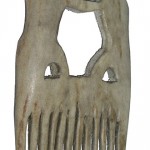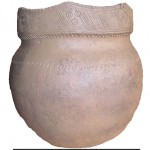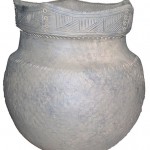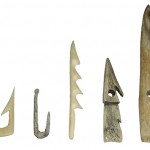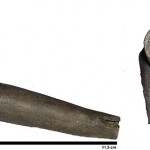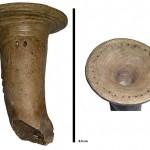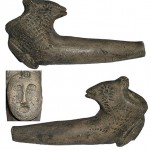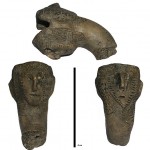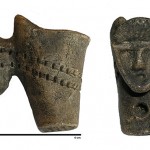Saint-Lawrence Iroquoians
On July 24th, 1534, Cartier encountered Iroquoians for the first time. At Point Penouille on the Gaspé coast, he met chief Donnaconna and a large group of fishermen. As they did every summer, these Iroquoians from Stadaconné had travelled there to amass a stock of sea mammals and fish. Cartier convinced Donnaconna’s two sons, Domagaya and Taignoagny, to go to France with him. He wanted them to act as interpreters. The following year, he took them back as far as the “province of Canada”, the Stadaconné region. Dreaming of finding a western passage to Cathay, he travelled upstream to Hochelaga, which he visited on October 3rd. He was astonished by the town’s size and complexity.
During his river journeys, he saw many villages and campsites. From Cap Tourmente to the Montreal archipelago, he saw the strong presence of the St. Lawrence Iroquoians, more than 10,000 people living by growing corn and fishing, rounded out by hunting.
When it was Champlain’s turn to travel up the great river, in 1608, approximately seventy years later, these Iroquoians had all disappeared of the St. Lawrence shores without leaving a trace of their villages.
Archaeology and ethnology have reconstructed parts of their history.
They were part of the larger family of Iroquoians, such as the League of Five Nations, the peoples of Huronia and of the Great Lakes. Vestiges of their villages have been found throughout the Saint Lawrence Valley, from the Thousand Islands to Tadoussac. They occupied the shores of the St. Lawrence for 500 years, from the 1000s to the 1600s. Quebecers have not yet reached such a length of occupancy.
Gardeners, fishers and occasionally hunters, they traded tools and goods with their neighbours in the boreal forests, the ancestors of the Crees, the Algonquins, the Atikamekws and the Innus.
Their villages incorporated longhouses where families lived in matrilineal-linked groups. The women took charge of households, grew corn and made pottery vases. As among all the Iroquoians, women seemed to hold the determining power. The men prepared the fields for farming, hunted, fished and traded.
They practised elaborate funeral rites to ensure the survival of the souls of the dead. Their ceremonial or pleasurable objects, such as pipes, were adorned with a bestiary and symbols evocative of rich belief and values systems. Cartier first described the important role of shamans and the animistic divinities that explained the ordering of the world.
They elaborated a set of practices that governed their relations with the seasons, animals and diseases. Their garments were adapted to the change of seasons. They had highly-organised hunting and fishing techniques. They used potions to ward off scurvy, medicinal teas and many kinds of cataplasms.
This people was well adapted to the St. Lawrence Valley. Their world was shaken by the arrival of the Europeans and the colonial upheaval it would bring about. It is plausible that their disappearance was caused by clashes with neighbours for control over their territory, which had become an essential route for the circulation of goods for trade with the new arrivals.
Videos
Long house
Video : Model of an Iroquoian longhouse
In this video, we see a model of an Iroquoian longhouse. Its structure is made of large wooden poles, rounded at the top and covered with bark. The typical longhouse looks like a loaf of bread, rounded on top, with one end sliced off. On this side a small roof supported by four poles is erected. The other end of the house is rounded.
These dwellings were huge. Indeed, if we compare the average height of a person to one of the entrance doors, we can see that these houses were easily three storeys high. The length of a longhouse was just as impressive as it had the dimensions of three houses in a row side by side. These houses had no windows; the openings were the front and side doors as well as the square air vents designed to let smoke out. These air vents were located atop the house. On the model, we can see four of them.
Later on in the video, we see two round earthenware vessels placed right next to a door on one side of the house. The following image shows us a close-up of the air vents on the roof.
The last shots depict the longhouse interior. We can clearly see the large rounded poles that provide the support structure. Lines have been stretched just under the roof of the house to dry corncobs. On each side of the inner walls, on the long sides, large platforms have been erected, each a storey high. There are four of these platforms, or two on each side. As these platforms are used as sleeping areas, dining areas and workplaces, different objects, rolled-up skins, tools and containers have been placed there. On the ground of the house, pottery has been placed near the hearths where fires are made.
Vase
Video : Typical example of Iroquoian pottery
This video shows a typical example of Iroquoian pottery made of terra cotta. It is very round in form and must be about 25cm in circumference. The top of the pot is made of a flattened neck, about 6cm high, with seven equidistant small points at the top of the neck. It is decorated with oblique hatchings traced in the clay before it was fired and three small, engraved circles arranged in a triangle like a mouth beneath two eyes. These circles are located directly under each of the seven points.
The last image depicts another piece of pottery, very similar to the first except that it has five, and not seven, points on its neck.
